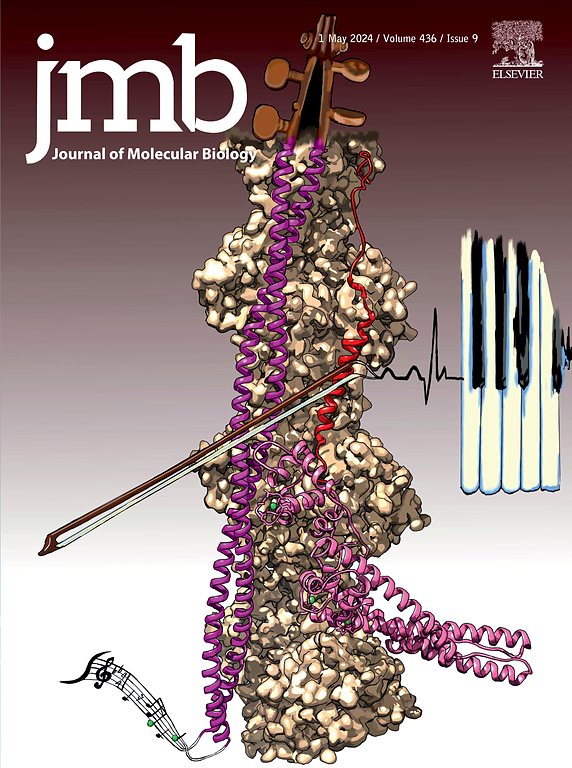鲍曼不动杆菌的膜修饰和代谢适应促进了外膜扰动肽L8的耐药性
IF 4.7
2区 生物学
Q1 BIOCHEMISTRY & MOLECULAR BIOLOGY
引用次数: 0
摘要
多药耐药鲍曼不动杆菌(Acinetobacter baumannii)已成为世界范围内最受关注的医院病原体之一。针对多药耐药鲍曼杆菌的一种方法是外膜渗透性抗菌肽(AMP)和抗生素的协同组合治疗,否则仅针对革兰氏阳性细菌。很少观察到对AMPs的耐药性,特别是当与其他药物联合使用时。最近,我们报道了AMPs L8和L8S1与利福平对鲍曼不动杆菌临床分离株的协同抑菌活性。在目前的工作中,我们探索这些肽的作用机制。我们证明L8和L8S1扰乱鲍曼不动杆菌的细胞包膜。此外,我们还表明,通过增加表面PE脂质的数量或增加生物膜的形成,可以在体外获得对肽L8的抗性。有趣的是,对这些肽的抗菌活性的耐药性并不影响这些肽与利福平的膜扰动或协同活性,这表明这些肽具有双重作用机制。本文章由计算机程序翻译,如有差异,请以英文原文为准。

Membrane Modification and Adaptation of Metabolism by Acinetobacter baumannii Prompts Resistance to Antimicrobial Activity of Outer Membrane Perturbing Peptide L8
Multidrug resistant (MDR) Acinetobacter baumannii has emerged as one of the most concerning nosocomial pathogens worldwide. One approach to target MDR A. baumannii is treatment with synergistic combinations of outer membrane-permeabilizing antimicrobial peptides (AMP) and antibiotics that otherwise only act against Gram-positive bacteria. Resistance against AMPs is rarely observed, especially when administered in combination with other drugs. Recently, we described the synergistic antimicrobial activity of AMPs L8 and L8S1 with rifampicin against a clinical isolate of A. baumannii. In the current work we explore the mechanisms of action of these peptides. We demonstrate that L8 and L8S1 perturb the cell envelope of A. baumannii. Moreover, we show that resistance against peptide L8 could be acquired in vitro either by increasing the amount of PE lipid on the surface or by increasing biofilm formation. Interestingly, the resistance to the antimicrobial activity of the peptides did not affect membrane perturbation or synergistic activity of the peptides with rifampicin, suggesting a dual mechanism of action for these peptides.
求助全文
通过发布文献求助,成功后即可免费获取论文全文。
去求助
来源期刊

Journal of Molecular Biology
生物-生化与分子生物学
CiteScore
11.30
自引率
1.80%
发文量
412
审稿时长
28 days
期刊介绍:
Journal of Molecular Biology (JMB) provides high quality, comprehensive and broad coverage in all areas of molecular biology. The journal publishes original scientific research papers that provide mechanistic and functional insights and report a significant advance to the field. The journal encourages the submission of multidisciplinary studies that use complementary experimental and computational approaches to address challenging biological questions.
Research areas include but are not limited to: Biomolecular interactions, signaling networks, systems biology; Cell cycle, cell growth, cell differentiation; Cell death, autophagy; Cell signaling and regulation; Chemical biology; Computational biology, in combination with experimental studies; DNA replication, repair, and recombination; Development, regenerative biology, mechanistic and functional studies of stem cells; Epigenetics, chromatin structure and function; Gene expression; Membrane processes, cell surface proteins and cell-cell interactions; Methodological advances, both experimental and theoretical, including databases; Microbiology, virology, and interactions with the host or environment; Microbiota mechanistic and functional studies; Nuclear organization; Post-translational modifications, proteomics; Processing and function of biologically important macromolecules and complexes; Molecular basis of disease; RNA processing, structure and functions of non-coding RNAs, transcription; Sorting, spatiotemporal organization, trafficking; Structural biology; Synthetic biology; Translation, protein folding, chaperones, protein degradation and quality control.
 求助内容:
求助内容: 应助结果提醒方式:
应助结果提醒方式:


